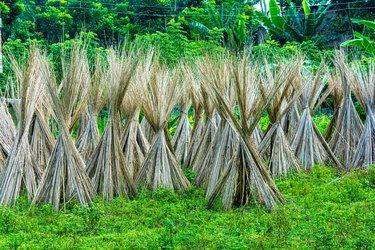
You may have heard of it in rugs, curtains and other things made from textiles, but is jute a plant, a type of material or a style of weaving? The first two are both correct: Jute fibers come from the white jute plant (Corchorus capsularis, USDA plant hardiness zones 9-11) and the toss jute (Corchorus olitorius, zones 9-11). The jute's material is a natural, silky golden fiber that gets extracted from the plant's bark. Another kind of jute plant, saluyot (Corchorus olitorius, zones 9-11), is edible and popular in places like Africa and Bangladesh.
Growing a Jute Plant
Video of the Day
Planted from March to May depending on the type of land and rainfall, jute plants are a rainy-season crop that gets harvested from June through September. It does best in warm, humid climates with temperatures from 75 to 98 degrees Fahrenheit, but too much rain is not suitable for them. They do best in clay and sandy loams; clay and sandy soils will not work for jute. The best pH is about 6.4, and you should avoid areas prone to flooding; water logging is especially harmful during the seedling stage. Jute seeds are planted by farmers, but it is possible to grow them in pots at home if you can find jute seeds.
Video of the Day
Use rich potting soil and test the pH; you can sow the seeds right on top, spreading them to 1 inch apart. Cover lightly with soil and put the pot in a sunny, warm location. Give the jute plant at least 2 inches of water weekly. Once the seedlings are 6 to 8 inches tall, you can transplant them outside. The harvesting and fiber extraction process is a bit more complicated and involves steeping, large tanks, stripping off the fibers and drying them.
A Different Kind of Jute
The saluyot plant is a specific type of jute that is also referred to as Nalta jute, Jew's mallow and Egyptian spinach. It is a very different specimen than the varieties used to produce the valued jute fiber. Saluyot is an annual tropical herb with small clusters of flowers, capsule-shaped fruits and green shiny leaves and stalks. Best of all, this plant has medicinal use and is edible.
Saluyot leaves taste bitter when fresh, so you'll need to cook them in order to get the best results from the plant. However, the good news is that the taste significantly improves when cooked. Chefs often use saluyot jute in soups and stews and brewed into teas. The seeds and leaves can help with digestion, and the stems are used to make paper and sack cloth. The wood is also usable; companies use it to make sulfur matches among other things.
How to Grow Saluyot
You can buy saluyot seeds online, and once they arrive, you can sow them into a planting container with drainage holes. Your first step is to fill that container with a mixture of 60 percent soil and 40 percent compost. Then, you should sprinkle the seeds on top of the soil, scattering them as evenly as possible to improve the chances of a healthy plant. You'll need to water the seeds well and put the container in a shaded area. If everything goes well, you should see sprouts in about three days.
Once you see the sprouts, you'll want to transfer your container into full sunlight and water once a day. After about 10 days, you should see more growth. They like soggy soil but do not overwater these plants. You can use them as microgreens at this stage or wait until they develop into seedlings. After 15 days, you will be able to harvest the leaves.